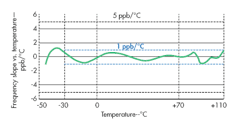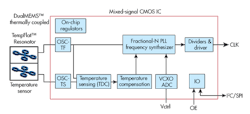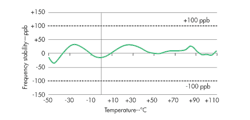MEMS Oscillators Offer Precision Timing
This file type includes high resolution graphics and schematics when applicable.
Timing and synchronization of components and subsystems are necessary for many electronic systems, typically relying upon the stability of a reference oscillator. Until now, system timing in high-performance applications was typically based on a stabilized crystal oscillator, such as a temperature-compensated crystal oscillator (TCXO) or oven-controlled crystal oscillator (OCXO); however, miniature oscillators based on microelectromechanical-systems (MEMS) technology offer a new timing alternative with impressive stability for a wide range of timing requirements. In addition, the silicon MEMS-based oscillator families in the new Elite Platform product line from SiTime push the performance of this technology to new levels, in the presence of changing environmental conditions, for any clock frequency from 1 to 220 MHz and as high as 700 MHz for differential outputs.
Quartz has been a building-block material for stable oscillators for some time, providing excellent frequency stability. The most demanding requirements, however, require that quartz oscillators are compensated or stabilized in some way because they are susceptible to rapid changes in temperature. One solution involves using an OCXO, although they tend to be relatively large (compared to an uncompensated crystal oscillator) and require considerable power consumption to maintain constant temperature within an oven-controlled package. OCXOs also employ fairly complex construction, which can compromise reliability. Quartz is also susceptible to the effects of environmental noise, such as vibration, and can suffer frequency variations in such environments.
Sufficient vibration at a wireless cellular base station or small cell employing a quartz-based clock oscillator can result in dropped calls and lost data for transmissions within that wireless network. In addition, quartz oscillators can suffer frequency instability with rapid changes in temperature and over a wide operating temperature range. The stability requirements of a particular communications network will dictate the type of time-keeping oscillator required for that system. As an example, IEEE1588 Grandmaster clocks, which are often specified for precision network synchronization applications, have a frequency-over-temperature-slope (Δf/ΔT) requirement of 1 ppb/°C. Such a challenging requirement calls for an oscillator that is relatively immune to the effects of rapid temperature changes in the surrounding environment, such as an OCXO. A quartz-based OCXO oscillator provides outstanding frequency stability with rapid changes in temperature, although in a much larger package (because of the oven) than a standard quartz oscillator and with much greater power consumption than a standard quartz oscillator.
In contrast, the new MEMS oscillators from SiTime are based on silicon, not quartz (Fig. 1). They offer the Δf/ΔT performance for an application like IEEE 1588 Grandmaster clocks (1 ppb/°C) in a fraction of the size of an OCXO and with much less power consumption. The basic architecture consists of a pair of the company’s DualMEMS MEMS resonators—one for timing and the other for temperature sensing—connected to a mixed-signal silicon CMOS integrated circuit (IC) within a single package, such as an eight-lead SOIC-8 package. The CMOS IC includes the phase-lock-loop (PLL) circuitry needed for generated the required frequency and circuitry for maintaining high stability, such as on-chip temperature sensors, on-chip temperature compensation, and voltage regulation (Fig. 2). The different MEMS-based clock oscillators achieve impressive frequency stability with rapid temperature, changes, temperature variations due to airflow of in-system fans, power-supply fluctuations, mechanical shock and vibration, and other dynamic conditions common to applications in the field.
The MEMS Lineup
The new Elite Platform clock oscillators include MEMS VCXOs, differential MEMS oscillators (XOs), and Stratum-3-compliant Super-TCXOs. The differential MEMS oscillators and MEMS VCXOs are currently sampling while engineering samples of the Super-TCXOs will be available in the early part of 2017.
The differential MEMS oscillators are supplied in surface-mount QFN packages, measuring either 3.2 × 2.5 mm or 7.0 × 5.0 mm. Model SiT9365 oscillators are available for 32 standard frequencies, while model SiT9366 can be specified from 10 to 220 MHz and model SiT9367 from 220 to 700 MHz, both with frequency stabilities ranging from ±10 to ±50 ppm. The typical integrated RMS phase jitter (over 12 kHz to 20 MHz) is a mere 0.23 ps. These oscillators provide LVPECL, LVDS, and HCSL output formats. They are available for operating temperatures as wide as -40°C to +95°C. The differential MEMS VCXOs include model SiT3372, with frequencies from 10 to 220 MHz, and model SiT3373, with frequencies from 220 to 700 MHz. Both models are usable from -40°C to +95°C and supplied in QFN packages. Frequency stabilities range from ±10 to ±50 ppm with LVPECL, LVDS, and HCSL output formats.
The “standard” Super-TCXOs include model SiT5156, for frequencies from 1 to 60 MHz, and model SiT5157, for frequencies from 60 to 220 MHz, with both achieving frequency stabilities of ±0.5 ppm and ±0.5 to ±5 ppm, respectively. These clocks generate LVCMOS or clipped sinewave outputs. They are supplied in an SOIC-8 package measuring 6.0 × 4.9 mm. For even higher stability, the Precision Super-TCXOs include model SiT5356, with frequencies from 1 to 60 MHz, and model SiT5357, with frequencies from 60 to 220 MHz, and both devices also offer LVCMOS or clipped-sinewave output formats. These highly stable MEMS clock oscillators feature frequency stabilities of ±0.1 to ±0.25 ppm over temperature. Both Super-TCXO and Precision Super-TCXO families have operating temperature ranges as wide as -40°C to +105°C and are supplied in an SOIC-8 package.
In general, these MEMS-based clock oscillators offer excellent frequency stability over temperature (Fig. 3). The frequency stabilities of the Super-TCXOs is easily in excess of the ±100 ppm frequency stability required for synchronization of communications networks and small cells in wireless systems. The MEMS oscillators are essentially immune to vibration, with vibration sensitivity of 0.1 parts per billion per gravity (0.1 ppb/g). The oscillators exhibit an Allan deviation of 3 × 10-11 g, even better than the requirements of a Global Positioning System (GPS) clock. The oscillators also offer excellent airflow resistance, and are stable with dynamic changes in environmental conditions, such as rapid changes in temperature. The dynamic frequency stability is better than 5 ppb/°C for a 10°C/minute slope in temperature.
The Precision Super-TCXOs boast 0.2 ps/mV power supply noise rejection (PSNR), while the differential MEMS oscillators improve upon this to 0.02 ps/mV PSNR, eliminating the need for low-drop-out (LDO) linear regulators or expensive, dedicated power supplies (Fig. 4). The various MEMS VCXOs provide 0.1% frequency tuning linearity under all conditions, with optional I2C ports for frequency tuning, and replacing the need for an external digital-to-analog converter (DAC) for frequency tuning. The LVCMOS MEMS oscillators can be configured for optimum rise/fall times to achieve a desired jitter specification or for reduction of electromagnetic interference (EMI) in a particular application.
The trend in modern mobile communications systems, with the ever-growing number of wireless users and applications, is toward more compact, denser infrastructure equipment deployed in systems in less-controlled environments. These communications systems require small, low-power oscillators that provide high reliability and offer the dynamic performance needed for stable timing in uncontrolled environments. Even test equipment designers, as they look for smaller more modular footprints, will find needs for smaller, lower-power clock oscillators. For OCXO stability with a fraction of the size and power consumption, and with reliability that has been shown to be on the order of 1.5 failures per 1 million oscillators, these silicon MEMS oscillators represent a hard-to-beat solution.
SiTime, 5451 Patrick Henry Dr., Santa Clara, CA 95054; (408) 328-4400, www.sitime.com.
This file type includes high resolution graphics and schematics when applicable.
About the Author
Jack Browne
Technical Contributor
Jack Browne, Technical Contributor, has worked in technical publishing for over 30 years. He managed the content and production of three technical journals while at the American Institute of Physics, including Medical Physics and the Journal of Vacuum Science & Technology. He has been a Publisher and Editor for Penton Media, started the firm’s Wireless Symposium & Exhibition trade show in 1993, and currently serves as Technical Contributor for that company's Microwaves & RF magazine. Browne, who holds a BS in Mathematics from City College of New York and BA degrees in English and Philosophy from Fordham University, is a member of the IEEE.






